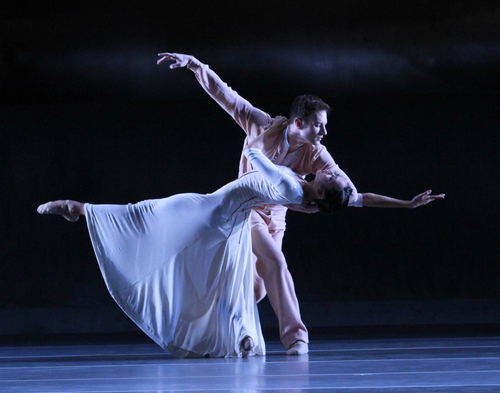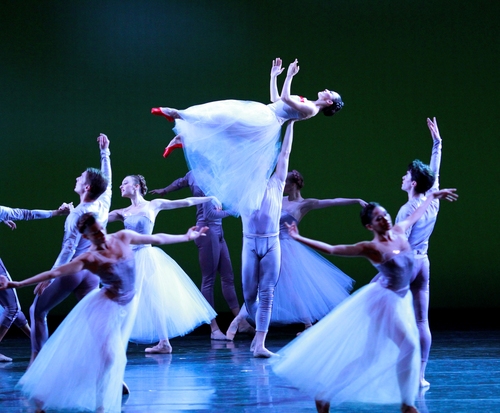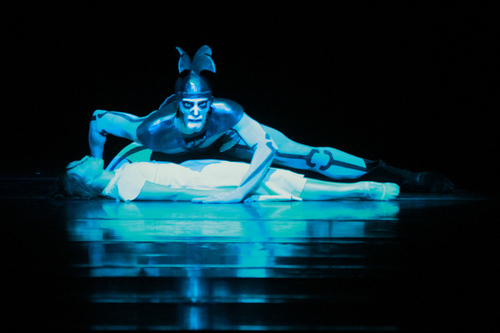| « Strawdog's Pontypool Delivers Quick-Paced Frights Just in Time for Halloween | Fashion Focus Chicago Celebrates the Chicago Fashion Incubator » |
Dance Sat Oct 20 2012
Review: The Joffrey Ballet's Human Landscapes at the Auditorium Theatre
Romanticism in performative outlets is not merely a means to highlight ideas of the beautiful. The idea of the "romantic," - in this case, focusing on love and relationships and the complications that arise within - is one that should be handled with care. Like many of the other works performed as part of the Joffrey Ballet's Human Landscapes fall engagement at the Auditorium Theatre, the routines and struggles that most of us encounter throughout our lives elicit gripping storytelling. Each work featured the live accompaniment of the Chicago Philharmonic, escalating the presence and the physicality of the movements.
In Jiří Kylián's Forgotten Land, the evening's opener, company members dance to instantly propulsive music by Benjamin Britten that pushes forward the progression of the movements from soft and delicate to rigid and confined. The flowing red, black, and white costumes as well as the choreography of the coupled dancers moved from intense togetherness to intense breaking apart. When together, the movements with the coupled dancers were often repetitious and completely coordinated. Eventually the couples were broken apart with only one remaining in the end. As in life, the work was a piece of transition and evolution, representing the coming together and moving apart of the relationships, whether romantic or not, in life.
Pretty BALLET, the evening's second work, was literal in its execution. Choreographer James Kudelka's work was less dramatic than Forgotten Land (and certainly less so than the evening's closing work), and ultimately less charismatic. It was a welcome break from the propulsive percussion that set the tone for Forgotten Land, but it frequently felt incomplete or unwarranted for the tone of the evening. Pretty BALLET created balance, but is balance even necessary when both Forgotten Land and The Green Table provided enough voiceless commentary to leave audiences in awe?
The evening ended with a bang ... literally. Kurt Jooss' 1932 anti-war masterpiece, The Green Table, was the most anticipated work of the evening not just because of its historical status as part of the contemporary ballet canon. It also proved to be a worthy step in the choice of choreography and theatricality for the company. The Joffrey often excels when given the challenge of forcing the role of their company as an outlet for classical or traditional ballet. And like in the past, the company's performance of The Green Table was a site to behold. The work - visually stunning, jarring, at times dedicated to the ideas and practices of the anti-dance movement - was unlike many other works seen or performed in the theatre. A group of dancers (the "Gentleman in Black") in suits stood gathered around a long, green table as they fired off one shot from fake guns. Members of the audience jumped in surprise and the noise was a welcome jolt to the evening.
That is not to say that the previous performances were dull. Only that the works conformed to classic Joffrey. The company was the first American group to perform the work in 1967 and yet the choreography, costumes, and topicality of the work felt as relevant as it might have in the 60s. Jooss' depicts the frustrations and difficulty of peace negotiations. Like the 1960s, the nation is in a time of war, although the circumstances are much more complicated than in the past. If anything, the work highlights our inability to grow and mature as a society.
What does it mean to have peace? We end conflict, but strife is a reality from year to year, decade to decade. Later scenes in the work include the many recognizable situations of war: the separation of loved ones, scenes of battle, the psychologically-wounded survivors in the aftermath. The lighting, costumes, and props were as dramatic as the movements, adding to the overall theatrical tone of the work. Movements were sharp and direct. This is not a pretty work, but one that settles heavily. Evident in each scene is "Death" (performed by audience-favorite company member Fabrice Calmels), a presence whose jarring and stilted movements serve as a lingering reminder of the repercussions of our actions.
--
The Joffrey Ballet's "Human Landscapes" runs through October 28 at the Auditorium Theatre. Single tickets range from $31 to $152 and may be purchased at The Joffrey Ballet's official Box Office located in the lobby of Joffrey Tower (10 E. Randolph Street), as well as the Auditorium Theatre of Roosevelt University Box Office, all Ticketmaster Ticket Centers, by telephone at (800) 982-2787, or online.











